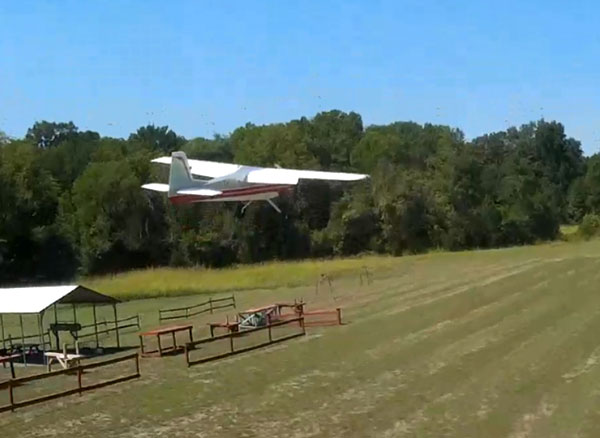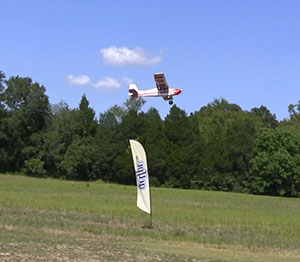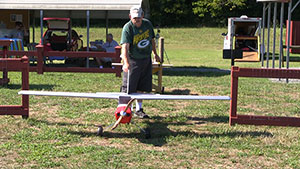



From day one the Valiant proved to be the best-flying airframe I have ever had.
Fast, slow and everything between, the Valiant does it all predictably.
Text, photos and video by Tom Hintz
Flight video by Clark Ponthier & Mike Basmajian
Posted – 9-15-2016
The Hangar 9 Valiant 30cc brings with it a reputation for being an exceptionally aerobatic high wing plane that also has superb low-speed capabilities. The instructions provide a complete list of control throws that it states should be considered a starting spot. Considering the uber-wide flight envelope, I decided to maiden the Hangar 9 Valiant 30cc at the standard control throws. Once I get it dialed in so that it flies straight and true I will begin increasing the control throws and perhaps even move the CG back some to liven it up if that still seems like a good idea. Every airframe has its limitations and I do not want to fail a big airplane in the sky. I do want to get all we can out of it but without endangering the Hangar 9 Valiant 30cc or surrounding objects and people.
We lucked out and bought the Hangar 9 Valiant 30cc out on a clear, calm day. Actually the first two days would be relatively wind free providing a great environment in which to sort out a new airplane. The DLE40 Twin had been sitting idle in a box in the shop for quite a while but started easily. I decided to leave it a bit rich for the first few flights to be sure the bearings and other components were getting all the oil they needed. It was obvious that the Hangar 9 Valiant 30cc was not going to be straining the DLE40 Twin just to get into the air so a little power lost to a rich carb was not going to be a problem.
The first take off lacked drama or excitement. The Hangar 9 Valiant 30cc lifted off of the ground and flew away in nearly perfect form. I did have to give it a few clicks of down elevator and a few more to the ailerons but that was all it took to get it flying straight and level. I also noted that there were no big trim changes when speed was varied from near walking pace to full power. The Hangar 9 Valiant 30cc felt like it was on rails with “go where you point it” manners right off the bench.
I had forgotten to add some down elevator to the flap setup so decided that given the great flying conditions I would do the initial landings without flaps at all. This also showed me that the Hangar 9 Valiant 30cc does not have a large frontal area which may in part explain its surprising speed. On landings the clean aerodynamic shape meant that the Hangar 9 Valiant 30cc took longer than expected to scrub off speed. Landings without flaps needed to be set up a little farther out to get the landing speed down. Again, not a big problem because the Hangar 9 Valiant 30cc flies so well at all speeds.
A couple days after this photo was taken
I was goofing around with the Valiant,
inverted at this height when the engine
ran out of gas. I rolled it over and
landed on the field. Like I said, the
best flying airframe ever!
For the second flight I added 10% down elevator to the half flap setting and 20% to full flaps. That made the plane much more manageable but drop the flaps with a little too much airspeed and the Hangar 9 Valiant 30cc noses up. Keep the speed down and the Hangar 9 Valiant 30cc is a puppy to land with full flaps. It does need just a little speed to maintain its stability but far less than I would expect with most planes. The reduced throws also mean that if you get too slow you can run out of elevator and bump the wheels as the Hangar 9 Valiant 30cc decides that it has had enough and drops to the ground but almost gently. Landing speed is easily manageable once you get a couple flights under your belt. Later during the first day I was able to keep the wheels about 6” off of the ground all the way down the runway by bumping a little throttle and working the elevator.
At the suggested throws the Hangar 9 Valiant 30cc has a markedly slow roll rate. Because the manual has differential (more up than down) built into the aileron settings there does not appear to be any wandering of the nose as the plane rolls. I anticipate setting the ailerons up with all of the travel I can get up and down and then using the Differential capability of my Spektrum DX9 to find the right amount of differential. In the future I will be setting up Crow (a separate How-To on that is coming) so this configuration of the ailerons might be necessary rather than using different up and down mechanical throws.
The original aileron settings per the instruction manual helped cause a major pucker incident during a flight after we put the cameras away. I was making a low inverted pass when the DLE40 Twin just stopped. I had just enough airspeed to roll the Hangar 9 Valiant 30cc upright though the maneuver was painstakingly slow and felt like it was in slow motion. As I was watching the Hangar 9 Valiant 30cc do its roll I could see that the down side wing had about a foot of clearance from the ground. Once the Hangar 9 Valiant 30cc got right side up it started gliding nicely and I was able to get it down without damage. I don’t have a good explanation for the DLE40 Twin quitting like that but I am suspicious of the routing of the vent line on the tank and will check that out when I get the Hangar 9 Valiant 30cc back in the shop.
One of the things I was hopeful of was the Hangar 9 Valiant 30cc being a good candidate for heavy rudder use. I love sliding a plane around the final turn into the runway. I use the rudder a lot anyway but a plane like the Hangar 9 Valiant 30cc makes it even more fun because of how much rudder can be used without upsetting the airframe in a bad way. It is remarkably easy to “slip” (fly sort of sideways) the Hangar 9 Valiant 30cc using opposite aileron to manage the angle of the wing and the elevator to control altitude. I know this seems like a complicated maneuver to many pilots but once you get used to it, especially on a rudder-friendly plane like the Hangar 9 Valiant 30cc this bit of cross-stick trickery becomes fun. It can also be handy at airfields where you need to reduce landing speed quickly. Slipping a plane definitely increases drag and helps lose speed with control.
An interesting trait of the Hangar 9 Valiant 30cc is a very sensitive rudder in knife edge flight. This plane also has a considerable amount of “coupling” where tries to roll or otherwise deflect from straight flight as the rudder is applied to maintain knife edge flight. This coupling is not uncommon, especially with a high wing airframe. The good news is that the Hangar 9 Valiant 30cc responds to corrective mixing where we program in countering forces with the ailerons and/or elevator to let the plane fly straight in knife edge flight. This does take some trial and error but with the capability of modern radios you also can have a big, high wing plane that flies knife edge on rails. We will be looking at the process of creating this knife edge mix in the next segment of the Hangar 9 Valiant 30cc build series.

The biggest issue with the Valiant is
that it's nearly to wide for the openings
to the runway.
Going through the maiden flights proves in no uncertain terms that the Hangar 9 Valiant 30cc is a smooth, consistent flying plane that has no bad habits in any reasonable configuration. The base control throws give you an easy to fly predictable plane with surprising aerobatic capabilities. The Hangar 9 Valiant 30cc is also much faster than anyone I know suspected before flying one. This is a clean airframe with a relatively narrow fuselage that lets it extract lots of speed from a standard 30 to 40cc engine. The good news is that despite its high speed capabilities the Hangar 9 Valiant 30cc remains easy to fly and predictable at surprisingly low speed. The flaps at their prescribed angles are effective without compromising control at lower speeds.
I have been asked repeatedly since posting the first segment of this review is the Hangar 9 Valiant 30cc could serve as a trainer for someone getting into giant scale aircraft. Given someone who is qualified to fly such a plane and a buddy box system for everyone’s safety the Hangar 9 Valiant 30cc absolutely is trainer material. It has all of the characteristics of the old Kadet 40-glow size trainers we used to use but it is big enough to be seen more easily. The Hangar 9 Valiant 30cc has no bad habits to teach around and can be easily configured to be more gentle or more active to better fit a student pilots growing skill set. I would have no reservations teaching a new RC pilot on the Hangar 9 Valiant 30cc using a buddy box. There simply are no good reasons to start with a smaller high wing or foamie when you can use the stability and versatility of the Hangar 9 Valiant 30cc to show someone how to enjoy this hobby.
Now that the Hangar 9 Valiant 30cc has been flown extensively over a few days and is trimmed out I want to start stepping up its performance in terms of control throws and perhaps CG. The Hangar 9 Valiant 30cc flies so nicely that it makes me wonder how it would be with more radical control surface deflections. I will use the magic of the dual rate system so I can flip a switch and go right back to the base control throws if the bigger movements prove to be overly sensitive.
I also want to perfect the knife edge flight settings. It just looks odd for a big high wing plane like this to fly knife edge with any kind of stability and I am convinced this is a model that can do just that especially since I know someone who is already flying a Hangar 9 Valiant 30cc in knife edge.
We also will be finishing a story on using “Crow” in a powered plane like this. I think the results of that experiment will be interesting so keep an eye out for that story in the weeks to come.
See the Hangar 9 Valiant 30cc Segment 1 – Click Here
See the Hangar 9 Valiant 30cc Segment 2 – Click Here
Have a comment on this Review? –Email Me!